
|
|

June 11, 2010
WNYC, New York - Before and After
About a decade ago, your editor began trying to document as much as possible about the current state of radio in the nation's biggest market, New York City. It's a market I try to visit as often as possible, because there's always something to see - and because, especially over the last decade, there's always something changing. (And, yes, because I'm still researching the long-delayed but still-underway Airwaves of New York, Volume II.)
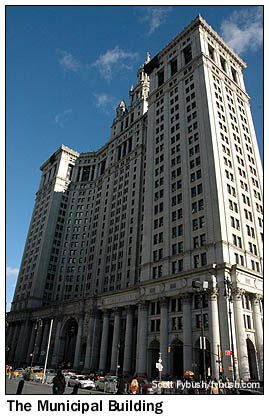 Since
2001, nearly every major commercial station in New York has built
new studios, and it's been thrilling to watch (and photograph!)
as engineers have dismantled studio space in the ever-more-expensive
precincts of midtown Manhattan, replacing them with (slightly)
less expensive new spaces a few stops south on the 1 train in
lower Manhattan. The three Emmis FM stations made the move first
- they've been ensconced on Hudson Street since the '90s - followed
in quick succession in more recent years by WOR (from 1440 Broadway
in Times Square down to 111 Broadway near Wall Street), CBS Radio
(consolidating stations from several midtown locations at 345
Hudson Street near the Holland Tunnel) and Clear Channel (moving
its five FMs from midtown and New Jersey to the old AT&T
Building at Sixth Avenue and Canal Street).
Since
2001, nearly every major commercial station in New York has built
new studios, and it's been thrilling to watch (and photograph!)
as engineers have dismantled studio space in the ever-more-expensive
precincts of midtown Manhattan, replacing them with (slightly)
less expensive new spaces a few stops south on the 1 train in
lower Manhattan. The three Emmis FM stations made the move first
- they've been ensconced on Hudson Street since the '90s - followed
in quick succession in more recent years by WOR (from 1440 Broadway
in Times Square down to 111 Broadway near Wall Street), CBS Radio
(consolidating stations from several midtown locations at 345
Hudson Street near the Holland Tunnel) and Clear Channel (moving
its five FMs from midtown and New Jersey to the old AT&T
Building at Sixth Avenue and Canal Street).
Then there's lower Manhattan's oldest radio occupant, WNYC (820/93.9), which signed on in 1924 from the monumental Municipal Building across from City Hall. While it moved around the building a bit (and eventually moved its AM and FM transmitter sites away from the building), WNYC remained at home on the upper floors of the Municipal Building for an amazing 85 years. For most of that time, it had no reason to move: the station was owned by the city, after all, and enjoyed a rent-free existence up there.
But once the city sold WNYC to a listener-supported nonprofit foundation a few years back, it needed a new home pretty desperately. Not only did the city want to reclaim the space (it's now home to WNYE FM/TV, which were transferred from the city schools to the city itself), but WNYC urgently needed space that was more suitable to its current production needs.
When your editor first visited the old WNYC in 2007, it was an eye-opener: WNYC's staff was spread across some eight floors of the building, largely on the 24th and 25th floor, but with offices and production rooms all over the place.
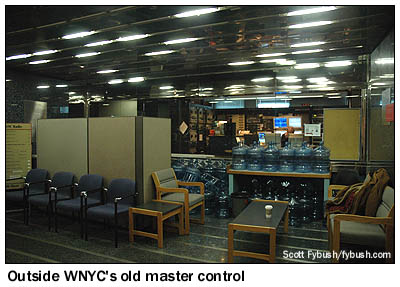
|
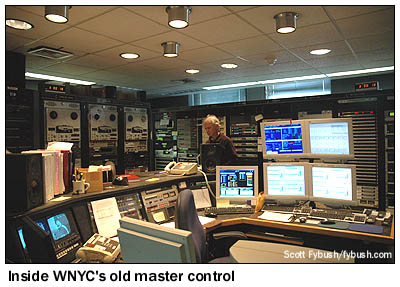
|
Administrative offices were in one corner of the building, air studios were in a 1980s-era space down the hall, the newsroom had long outgrown its cramped space, and offices and studios for WNYC's many local and network productions - the daily Brian Lehrer and Leonard Lopate talk shows, "Studio 360," "On the Media," and so on - were tucked away wherever there was room, some on the small floors of the Municipal Building's central tower, some in spaces that had evidently once had other uses entirely. (I remember finding several news department employees and a small voiceover booth in what had once clearly been a men's room!)
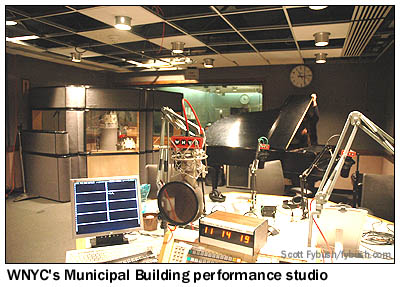
|
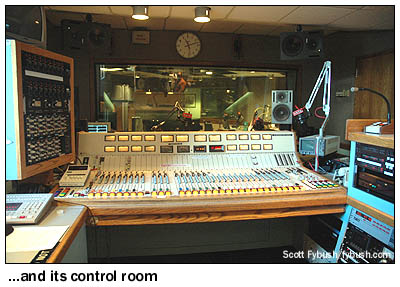
|
WNYC's master control had been part of the 1980s renovation, and it was showing its age, too, being largely tape-based and decidedly analog. And while WNYC boasted of being the only radio station in the country with a full-time archivist keeping track of its history, Andy Lanset toiled in a tiny, packed space at the very top of the Municipal Building tower, with most of his archives stored off-site.
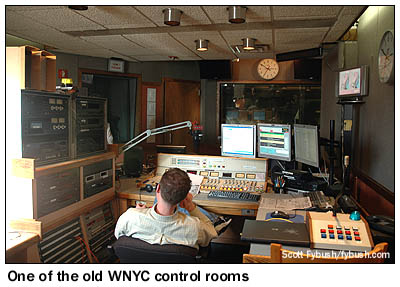
|
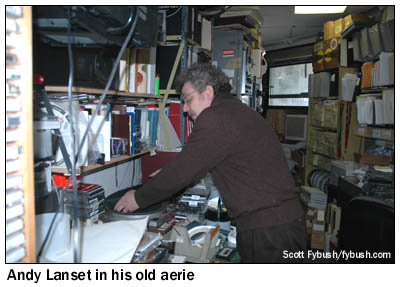
|
WNYC was already planning its move when we first visited: with the help of a major capital campaign, it had secured a much larger space in a former printing plant at 160-170 Varick Street, a few blocks west of its old home, and by 2008 construction was underway on the new facility.
We stopped by several times during construction, but it wasn't until our most recent visit in early 2010 that we had the chance to see WNYC's completed $45 million facility and to share it with you.
The new WNYC takes up 72,000 square feet on three floors of the Varick Street building, starting with a lobby on the eighth floor that enjoys a spectacular view to the north and east (including a line-of-sight view to the Empire State Building where the WNYC-FM transmitter is located!)
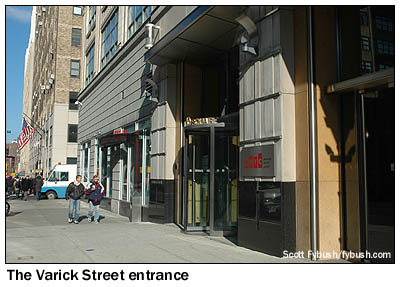
|
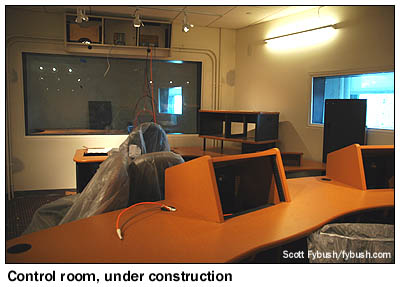
|
The seventh floor is home to some administrative and business offices, one rack room (there's one on every floor, with the seventh-floor room handling most of WNYC's IT and telco needs) and the new archives space, which we'll come back to shortly.
It's on the eighth floor that the most dramatic change is visible: instead of a tiny, cramped newsroom, the southwest corner of the floor is a big, sunny open space filled with enough cubicle space to accommodate all of WNYC's daily news operations. The closer the newsroom gets to the studio core in the southeast corner, the more deadline-critical the operation - WNYC's hourly news anchors and editors work just across the glass from two mirror-image studio/control room complexes.
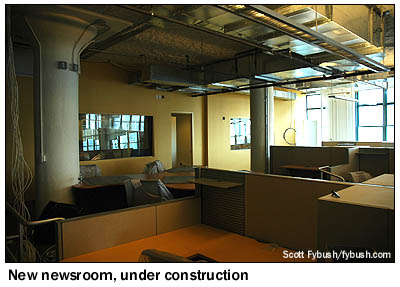
|
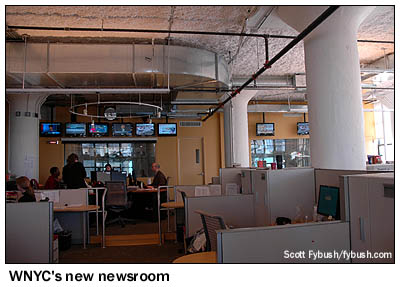
|
These studios are where most of WNYC's daily air product emanates, with shows and newscasts alternating from one to the other as needed. The Leonard Lopate and Brian Lehrer shows broadcast from these studios, as do the local portions of "Morning Edition" and "All Things Considered."
The studios themselves are fairly simple: four mic positions and the usual complement of computer screens and telephone controls for the host; across the glass, the control surfaces are all SAS Rubicon boards (we'll see a lot of these in New York's other new studios, too), with a well-equipped producer's station at the back of the control room, overlooking the console and the studio. Those clock/TV turrets above the glass are standard in just about every studio, too.
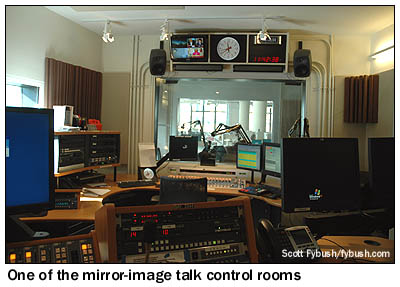
|
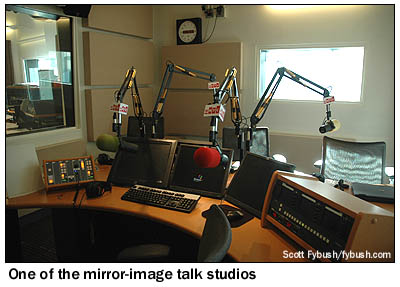
|
Behind the mirror-image talk studios, there's a well-equipped performance and production space where WNYC's live music broadcasts can originate. Look very carefully at that production console and you'll see (just under the Vision logo) a drop-in insert made by SAS to interface the console with the station's SAS router system, allowing this room, too, to connect to any of WNYC's zillions of audio sources.
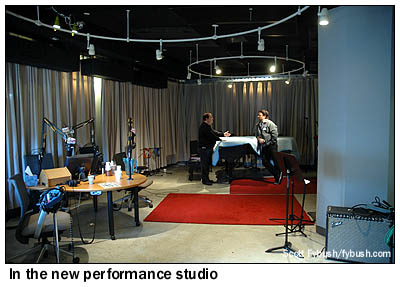
|
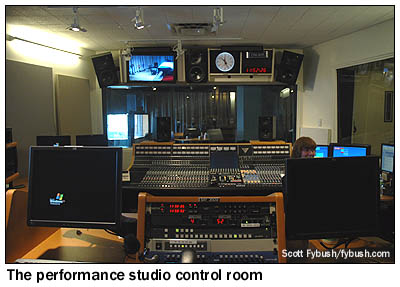
|
Moving back toward the big newsroom, there's a small but very functional master-control room where WNYC's transmitters are monitored and automation is programmed and checked. This room backs up to another small rack room that's largely devoted to all the "goezintas" and "goezoutas" that a big public radio station needs: dozens of ISDN codecs, IP codecs. telco hybrids, Content Depot receivers, EAS units and whatnot. (Instead of putting separate codecs and ISDN lines in each studio, they're all here and in a smaller rack room up on the ninth floor, accessible through the SAS router system from any studio in the building.)
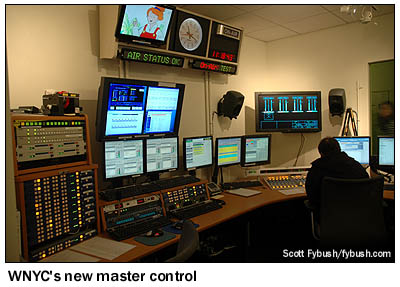
|
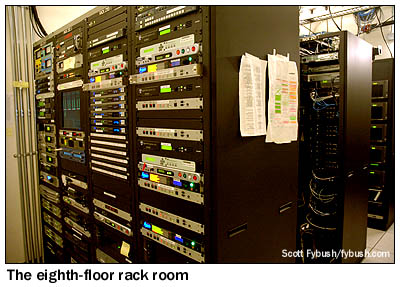
|
There are still more studios here on the eighth floor: a third control room/talk studio pair was supposed to be used by WNYC, like the mirror-image pair next door, but things have a way of changing: in mid-2009, WNYC purchased the intellectual property of venerable classical station WQXR (which had been at 96.3) and the license of what had been WCAA (105.9 Newark NJ), creating a new noncommercial WQXR at 105.9 on the dial. It's now housed in that third control room, with plans to modify it down the road to better fit an all-music format.
And tucked back in a corner of the studio core is another studio/control room pair for "The Takeaway," the new "alternative" public radio morning show that launched right around the same time WNYC moved in to the new building.
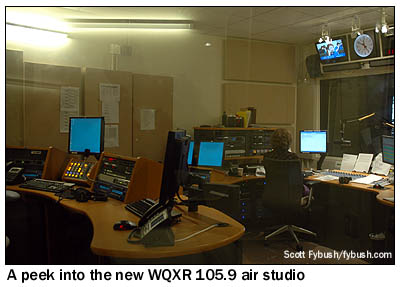
|
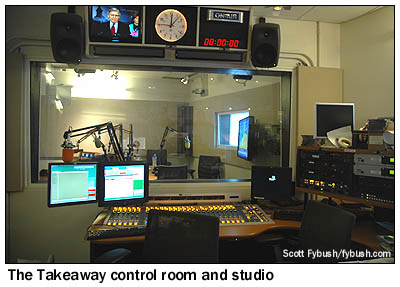
|
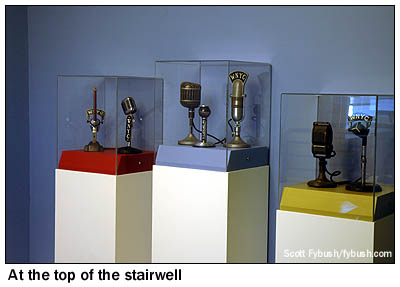
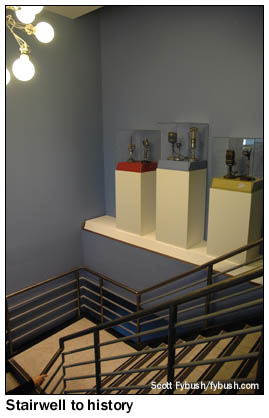 The
north side of the eighth floor is devoted to fundraising, if
I recall correctly - and up the flight of stairs that links all
three floors we find a small piece of WNYC's archival collection,
three cases full of the station's old microphones.
The
north side of the eighth floor is devoted to fundraising, if
I recall correctly - and up the flight of stairs that links all
three floors we find a small piece of WNYC's archival collection,
three cases full of the station's old microphones.
The ninth floor, which we don't have many pictures of for some reason, is home to still more WNYC studios: like the big newsroom on 8, there's a huge open-plan space on the south side of 9 that houses cubicles for the production staff of WNYC's less time-critical programming. Instead of being divided up in the warrens of the old Municipal Building, the staffs of "Studio 360," "On the Media," the Lehrer and Lopate shows, "Radio Lab" and other daily and weekly broadcasts all work together now, producing shows from another core of mostly smaller studios in the middle of the south side of the ninth floor.
Back down the stairwell we go to the seventh floor, where the southwest corner is home to those new archival spaces we mentioned earlier. Andy Lanset and his assistants now enjoy a large (and already cluttered!) workroom to collect, dub and preserve the histories of WNYC and WQXR - and an adjoining room with lots of movable shelving to hold many of the tapes and discs that used to be stored offsite.
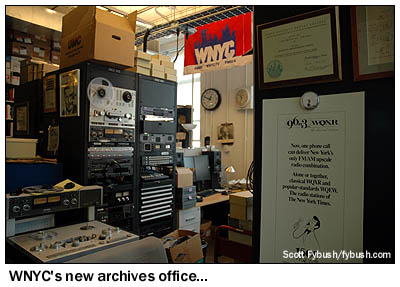
|
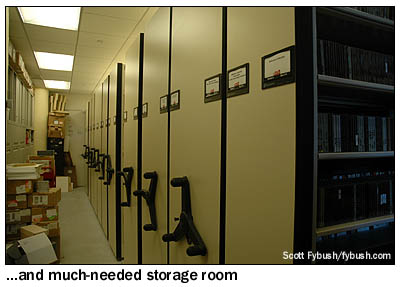
|
If this were the entire WNYC facility, it would already be one of the most impressive radio plants in the country - but we're still not done with our tour.
|
|
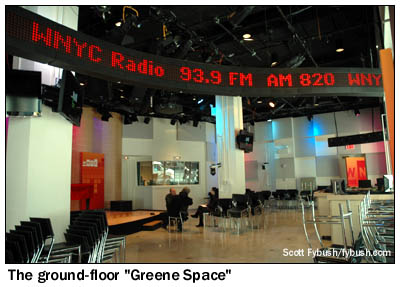
|
On the ground floor of the Varick Street building, there's still more WNYC production space. The huge Jerome L. Greene Performance Space - familiarly known as the "Greene Space" - quickly became an important part of New York's cultural landscape, home to live music performances, talk shows and lectures. It features welcoming windows looking out on the corner of Varick and Charlton, complete with a moving display ribbon that extends both inside the space and out to the facade of the building. And amazingly, this space is just a few feet above the subway line that runs just below Varick Street, riding on giant rubber pucks that insulate the room from the rumble of the trains below.
We'll have more of New York's radio rebuilding next week - and in the meantime, we urge you not to miss your chance to grab one of the dwindling remaining stash of the all-new Tower Site Calendar 2010, just in time to fill that space on the wall where your 2009 edition once hung.
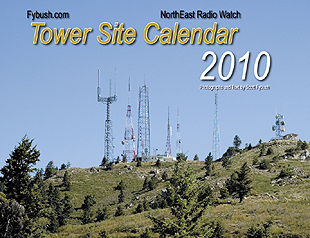 (It's
more than just pretty pictures and dates - the modest sum we
raise from each year's calendar helps make possible the travel
needed to make this feature happen every week on the website...and
we're grateful for all your support!)
(It's
more than just pretty pictures and dates - the modest sum we
raise from each year's calendar helps make possible the travel
needed to make this feature happen every week on the website...and
we're grateful for all your support!)
- Previous Site of the Week: WREK, Atlanta
- Next Week: Mount Beacon, Beacon, NY
- Site of the Week INDEX!
- How can you help support Site of the Week? Click here!
- Submit your suggestions for a future Site of the Week!
